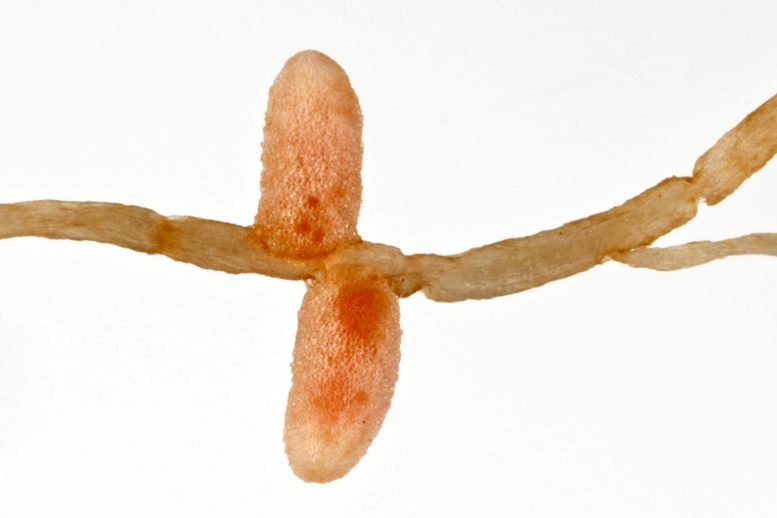
Legume Root nodules colored pink by leghaemoglobin and caused by a symbiotic relationship between the plant and beneficial bacteria. Credit: John Innes Centre
Scientists discover the genetics inside legumes that control the production of an oxygen-carrying molecule, crucial to the plant’s close relationships with nitrogen-fixing bacteria.
The finding offers the potential to give other plants the ability to produce ammonia from bacteria – reducing the need for the fossil fuel-dependent and polluting practice of applying synthetic fertilizer to crops.
The roots of legume plants are home to symbiotic bacteria. These bacteria can fix nitrogen from the air, turning it into ammonia, a key nutrient for plants.
In return, the plants house the bacteria in root nodules, providing sugars and oxygen. The amount of oxygen needs to be just right to support the symbiosis, the bacteria need oxygen to fuel their chemical reactions, but too much inhibits a key enzyme that turns nitrogen in the air into the ammonia that can be used by the plant.
The plant’s solution to this ‘oxygen paradox of biological nitrogen fixation’ is a molecule called leghemoglobin. Like hemoglobin that carries oxygen in our blood, leghemoglobin binds to oxygen and is red; it gives legume nodules their pink color. Until now it’s been unclear how plants control how much of this molecule is produced.
The research team have identified two transcription factors that control how much leghemoglobin is made in legume nodules.
“This gives a key insight into how legume plants create the microaerobic environment needed for nitrogen-fixation. This knowledge could be useful for improving nitrogen-fixation in legumes and would be essential for transfer of nodulation to non-legume crops, “explains corresponding author Dr. Jeremy Murray, CEPAMS Group Leader.
Dr. Jeremy Murray continues, “While many genes involved in other nodulation processes have been identified, this is the first breakthrough on the gene regulatory network involved directly in control of nitrogen fixation.”
The research was carried out by a collaborative team, led by Dr. Suyu Jiang in Dr Jeremy Murray’s group at the CAS-JIC Centre of Excellence for Plant and Microbial Science (CEPAMS), Centre for Excellence in Molecular Plant Sciences (CEMPS), Chinese Academy of Sciences, Shanghai, China, with collaboration from Dr. Pascal Gamas and Dr. Marie-Françoise Jardinaud at LIPME (Université de Toulouse, France).
Using the model legume, Medicago truncatula, the research team looked at a family of proteins in plants which has several members with roles in nodulation. They looked at which proteins in this class are produced in symbiosis-housing nodules and found that there was two – NIN and NLP2, and that when these are inactive, nitrogen fixation is reduced. This suggested that they are involved in nitrogen fixation.
To investigate further, they grew plants in an aeroponic system, without soil, to be able to look at the nodules, and found the plants lacking NIN and NLP2 were smaller in size and had smaller and less-pink nodules. On closer inspection, they had lower levels of leghemoglobin. Further experiments found that NIN and NLP2 directly activate the expression of leghemoglobin genes.
“This research project was purely curiosity-driven, all we knew at the outset was that the transcription factor we were studying was highly and specifically expressed in nitrogen-fixing cells, we were initially not aware of any connection to leghemoglobins,” reflects Dr. Murray.
The research has also given insights into the evolution of this important symbiosis. They found that other members of the transcription factors family regulate the production of non-symbiotic hemoglobins found in plants, which are involved in plant’s response to low oxygen levels.
Jeremy explains further, “This was exciting because it suggests that these transcription factors and their hemoglobin targets were recruited to nodulation as modules to help improve energetics in nitrogen-fixing cells, giving a rare glimpse into how this symbiosis evolved.”
Reference: “NIN-like protein transcription factors regulate leghemoglobin genes in legume nodules” by Suyu Jiang, Marie-Françoise Jardinaud, Jinpeng Gao, Yann Pecrix, Jiangqi Wen, Kirankumar Mysore, Ping Xu, Carmen Sanchez-Canizares, Yiting Ruan, Qiujiu Li, Meijun Zhu, Fuyu Li, Ertao Wang, Phillip S. Poole, Pascal Gamas and Jeremy D. Murray, 28 October 2021, Science.
DOI: 10.1126/science.abg5945









during daytime
sunlight shines
carbon dioxide in the air is taken in during daytime
produce sugars and oxygen binds to leghemoglobin nin nlp2 proteins and is the red pink nodules in legumes roots
water added h20
bacteria in the root nodules feed on
nitrogen from the air plus oxygen from the plant turning it into ammonia a key nutrient for the plant
excess oxygen released back into air during daytime
during nightime
moonlight shines
oxygen in air is taken back in
is this then linked to ammonia does this then mix with ammonia and produce
an excess carbon dioxide excess that is released back into the nighttime air
carbon dioxide for the plants reuse next day
a twofold symbiosis or is it just one way
thank you so much for taking the time to share a wonderful article.